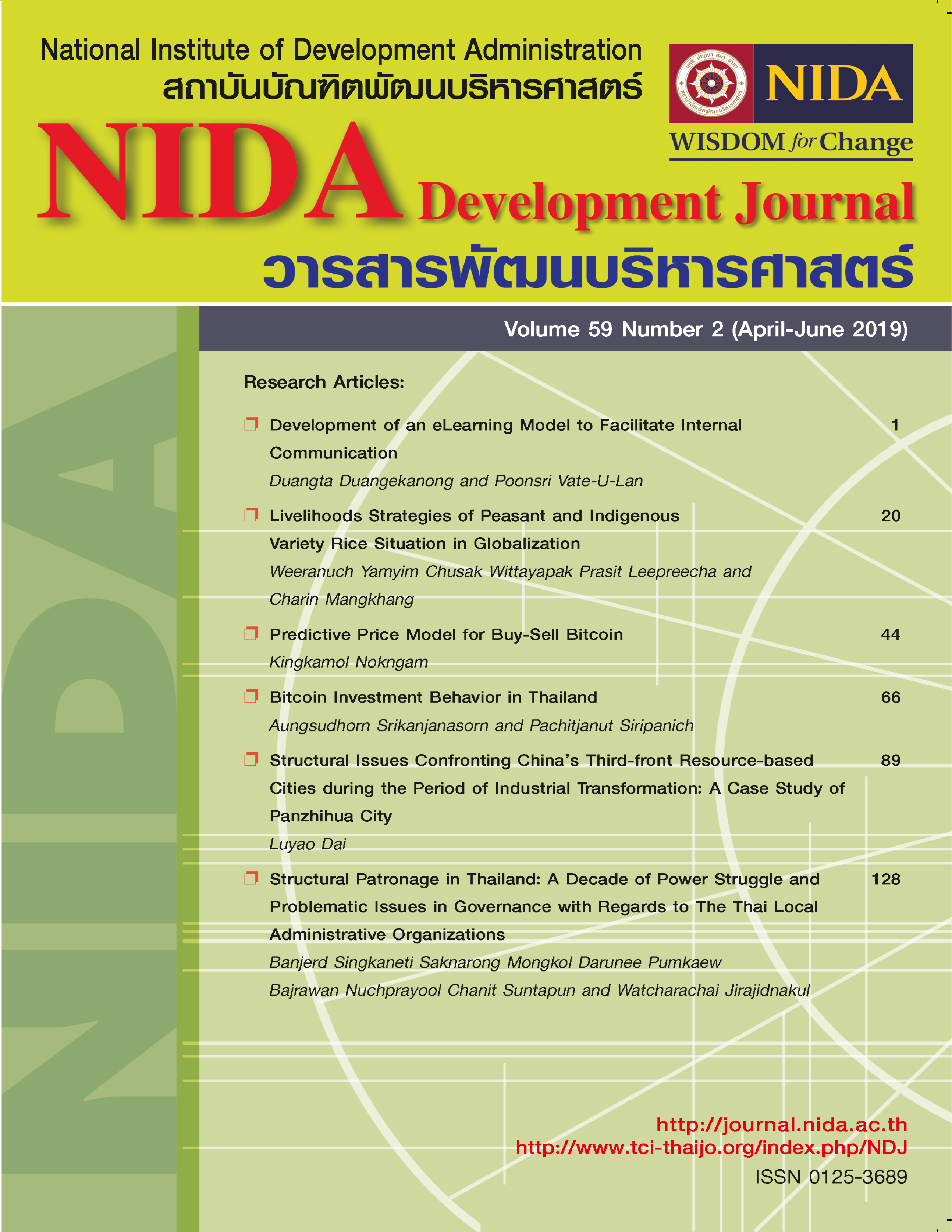การพัฒนารูปแบบการเรียนรู้แบบอีเลิร์นนิ่งเพื่ออำนวยความสะดวกในการสื่อสารภายใน
คำสำคัญ:
อีเลิร์นนิ่ง, การสื่อสารภายใน, การเปลี่ยนแปลงขององค์กรบทคัดย่อ
การวิจัยครั้งนี้มีวัตถุประสงค์เพื่อพัฒนารูปแบบแนวคิดสำหรับอีเลิร์นนิ่งซึ่งเป็นเครื่องมือสนับสนุนสำหรับการจัดการกระบวนการทางธุรกิจ การวิจัยครั้งนี้ใช้กรณีศึกษาแบบผสมเพื่อประเมินและทดสอบแบบจำลองการเรียนแบบอีเลิร์นนิ่งในองค์กร กรณีศึกษานี้มุ่งเน้นกระบวนการและขั้นตอนการสื่อสารภายในซึ่งเป็นประเด็นเฉพาะขององค์กร กรณีศึกษา รูปแบบการเรียนรู้แบบอีเลิร์นนิ่งได้รับการพัฒนาโดยการรวมการทดสอบเบื้องต้นและการตรวจสอบโดยผู้เชี่ยวชาญซึ่งระบุลักษณะพิเศษด้านการเรียนรู้แบบอีเลิร์นนิ่งแปดข้อซึ่งนำไปสู่ความรู้ด้านกระบวนการ (ประสิทธิภาพในการสื่อสารภายใน) โดยการรับรู้ประโยชน์ความพึงพอใจของผู้ใช้และการถ่ายทอดความรู้ หลังจากการการฝึกอบรมให้กับทางองค์กรแบบจำลองได้ทำการทดสอบอีกครั้ง การทดสอบอีกครั้งนี้แสดงให้เห็นว่ากรอบแนวคิดสามารถวัดประสิทธิภาพการสื่อสารภายในได้อย่างน่าเชื่อถือ ผลของการค้นพบนี้คืออีเลิร์นนิ่งเป็นเครื่องมือที่มีประสิทธิภาพในการสนับสนุนการจัดการกระบวนการทางธุรกิจและลักษณะเฉพาะของผลการฝึกอบรมที่มีอิทธิพลต่อการเรียนรู้แบบอีเลิร์นนิ่ง
เอกสารอ้างอิง
Bhuasiri, W., Xaymoungkhoun, O., Zo, H., Rho, J. J., & Ciganek, A. P. (2012). Critical success factors for e-learning in developing countries: A comparative analysis between ICT experts and faculty. Computers and Education, 58, 843-855.
Bottazzo, V. (2005). Intranet: A medium of internal communication and training. Information Services and Use, 25(2), 77-85.
Cañas, J. J., Fajardo, I., & Salmeron, L. (2006). Cognitive flexibility. In International encyclopedia of ergonomics and human factors (pp. 297-300). New York: Taylor & Francis.
Cho, V., Cheng, T. C., & Lai, W. M. (2009). The role of perceived user-interface design in continued usage intention of self-paced e-learning tools. Computers and Education, 53, 216-227.
Clark, R. C., & Mayer, R. E. (2016). E-learning and the science of instruction: Proven guidelines for consumers and designers of multimedia learning (4th ed.). Hoboken, NJ: John Wiley and Sons.
Cornelissen, J. (2004). Corporate communications theory and practice. Thousand Oaks, CA: Sage Publications.
Daniels, M. (2014). Discovery learning: Pros and cons. In D. C. Phillips (Ed.), Encyclopedia of educational theory and philosophy (pp. 235-238). Thousand Oaks, CA: Sage.
El Ouirdi, A., El Ouirdi, M., Segers, J., & Hendrickx, E. (2015). Employees' use of social media technologies: a methodological and thematic review . Behaviour and Information Technology, 34, 454-464.
Hearn, G. N., Foth, M., & Gray, H. L. (2009). Applications and implementations of new media in corporate communications: An action research approach. Corporate Communications, 14(1), 49-61.
Holsapple, C. W., & Lee-Post, A. (2006). Defining, assessing, and promoting e-learning success: An information systems perspective. Decision Sciences Journal of Innovative Education, 4(1), 67-85.
Lee, M. -C. (2010). Explaining and predicting users’ continuance intention toward e-learning: An extension of the expectation–confirmation model. Computers and Education, 54, 506-516.
Liaw, S. -S. (2008). Investigating students' perceived satisfaction, behavioral intention and effectiveness of e-learning: A case study of the Blackboard system. Computers and Education, 51(2), 864-873.
Mazzei, A. (2014). A multidisciplinary approach for a new understanding of corporate communication. Corporate Communication: An International Journal, 19(2), 216-230.
McCalman, J., Paton, R. A., & Sibert, S. (2015). Change management: A guide to effective implementation. Thousand Oaks, CA: Sage.
Phelps, R., Adams, R., & Bessant, J. (2007). Life cycles of growing organizations: A review with implications for knowledge and learning. International Journal of Management Reviews, 911-30.
Shee, D. Y., & Wang, Y. -S. (2008). Multi-criteria evaluation of the web-based e-learning system: A methodology based on learner satisfaction and its applications. Computers and Education, 50(3), 894-905.
Siritongthaworn, S., & Krairit, D. (2006). Satisfaction in e‐learning: the context of supplementary instruction . Campus-Wide Information Systems, 23(2), 76-91.
Tsai, M. -J. (2009). The model of strategic e-learning: Understanding and evaluating student e-learning from metacognitive perspectives. Journal of Educational Technology and Society, 12(1), 34-48.
Venkatesh, V., & Davis, F. D. (2000). A theoretical extension of the technology acceptance model: Four longitudinal field studies. Management science, 46(2), 186-204.
Verčič, A. T., Verčič, D., & Srirahmesh, K. (2012). Internal communication: Definition, parameters and the future. Public Relations Review, 38, 223-230.
Wang, Y. -S. (2003). Assessment of learner satisfaction with asynchronous electronic learning systems. Information and Management, 41(1), 75-86.
Welch, M., & Jackson, P. R. (2007). Rethinking internal communication: A stakeholder approach. Corporate Communications: An International Journal, 12(2), 177-198.
Welsh, E. T., Wanberg, C. R., Brown, K. G., & Simmering, M. J. (2003). E-learning: Emerging uses, empirical results and future directions. International Journal of Training and Development, 7(4), 245-258.
Yates, K. (2006). Internal communication effectiveness enhances bottom-line results. Journal of Organizational Excellence, 25(3), 71-79.
ดาวน์โหลด
เผยแพร่แล้ว
รูปแบบการอ้างอิง
ฉบับ
ประเภทบทความ
สัญญาอนุญาต

อนุญาตภายใต้เงื่อนไข Creative Commons Attribution-NonCommercial-NoDerivatives 4.0 International License.





